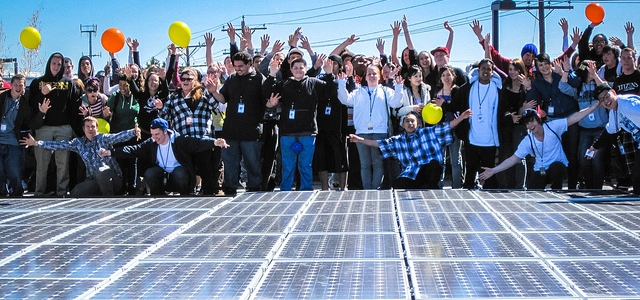How can public acceptance of utility projects be increased? Policymakers want to allow citizens to invest in such projects, but the focus is insufficient. Citizens want more than just financial benefits. By Craig Morris.

People come together in cooperatives to do the right thing, get to know each other, and create a sense of community. (Photo by Black Rock Solar, modified, CC BY 2.0)
Policymakers worldwide are looking for ways to detect and solve public opposition. They offer financial stakes and try to play down impacts – but studies repeatedly find no empirical evidence, say, that placing wind turbines further from buildings increases acceptance (PDF in German). As that study puts it, “It’s not enough to want to win over residents by providing them with information early on. Instead, people need to be able to participate early on – and have real input.”
Too often, policymakers and industry representatives assume that financial stakes are enough reward for the public. For instance, Denmark now requires various types of energy projects to offer 20 percent of the stakes to the public. But by the time those holdings are issued, the project is already well defined; citizens cannot shape the project’s design.
Another recent study entitled Prometheus (PDF in German) puts it quite well. In reviewing previous literature, the authors find that “most studies show that public officials and companies see citizen participation as a kind of early warning system.” Of course, transparency can help developers take account of possible public resistance, but this approach falls short because it still views citizens as reactive – as something to manage, not equals to engage with.
The authors of Prometheus explain that policymakers generally understand “public participation” to consist in “awareness-raising, financial incentives, and legislative design input.” But they argue that, “The success of the Energiewende… will also depend upon collective learning opportunities from political participation.” In other words, people want to speak eye to eye with industry experts and their political representatives. Laypeople want to explain their experience and have it taken into consideration; in return, community projects such as wind farms and district heat networks are an opportunity for citizens to learn more about how their country works. Politically, for instance, people learn what permits are needed and how to get them. And of course, investors who can help design a project also have to learn about technologies. An educated, politically involved public is the result – just what democracy needs.
Perhaps the most salient finding in Prometheus is what all of these studies overlook: Ergebnisoffenheit, meaning that the outcome is not fixed from the outset. When experts only engage with the public in order to bring citizens in line with the project (whose design is a foregone conclusion), participation devolves into outrage management. Here is an egregious example from the US – an excerpt from Peter Sandman’s Responding to community outrage:
“I am assuming that people are very upset about some risk, or likely to become very upset about it; that you do not believe their level of concern is technically justified; and that you are looking for ways to understand and respond better.”
Sandman only includes one other option, which he says his book does not investigate: when “officials are trying to break through public denial or apathy about a serious hazard,” such as when “agencies try to persuade homeowners to test for radon.” In both cases, the experts are right and the public is wrong. And when an expert meets with laypeople explicitly to explain why they are wrong, outrage is an understandable response. Mere “outrage management” therefore might even contribute to the problem it aims to solve.
When done properly, participation allows the people affected to shape a project’s design. For instance, a citizen of Freiamt wanted to build a wind farm, but he could only get his community to support three turbines initially. Eventually, ten were built as citizens experienced the machines firsthand (video). (And if you’re worried that such small projects won’t move us fast enough in fighting climate change, keep in mind that the German government is currently trying to slow down community projects.)
The Prometheus study lists a wide range of benefits citizens have from community projects. People come together in cooperatives to do the right thing, get to know each other, and create a sense of community. Some of these projects focus on profits, especially those in the energy sector, but most don’t (think of fire brigades, sport clubs, kindergartens, etc.).
And that is the main difference between community energy projects and those run by corporate utilities, with citizens as shareholders. If the corporate utility does not pay a dividend, all shareholders are upset – because they are only in it for the money, and profits are all they get.
Craig Morris (@PPchef) is the lead author of German Energy Transition. He directs Petite Planète and writes every workday for Renewables International.
The EU Parliament demanded in March to streamline (so far national) micro generation rules, esp. communities should be included in this streamlining (see from point 27 onward for co-ownership and so on):
http://eur-lex.europa.eu/legal-content/EN/TXT/?uri=CELEX:52013IP0374
Point 20 is interesting for the plug-and-play generators (“Guerilla PV”), the best-practice approach to get a fast uptake is demanded.
Plug-and-play is outspoken legalized in only 3 countries in the EU, Portugal, Netherlands and Switzerland.
Good information. Lucky me I came across your website by accident (stumbleupon).